
Kitguru rates the GTX750ti very highly – we have reviewed a handful of partner cards since Nvidia launched the model earlier this year. For the modest asking price it delivers solid frame rates at 1080p – but it is the Maxwell architecture that deserves special praise. These cards run exceptionally cool and take all the power they need direct from the PCI e slot. We like the combination of high efficiency, low noise and modest heat output – Nvidia seemed focused this year on reducing power demand which can only be seen as a positive step forward.

The ASUS STRIX cards that we have reviewed in recent months have certainly tickled our taste buds. The rather catchy STRIX moniker is taken from the ancient Roman and Greek for ‘OWL’. ASUS say ‘ STRIX means the keenest hearing and sharpest eyesight. Strix means feeling your environment so that you detect and react to the slightest movement. Strix means survival on the very edge of instinct. Strix is in your blood, as it is in ours.‘
The STRIX coolers use a semi passive fan profile … meaning that as the thermal curve drops the fans will spin very slowly – eventually stopping completely. This actually makes this ASUS solution today one of the most interesting we have looked at to date.
| GPU | Ref GK107 (Kepler) | Ref GM107 (Maxwell) | Asus GTX750ti Strix OC |
| CUDA Cores | 384 | 640 | 640 |
| Base Clock | 1058mhz | 1020mhz | 1124mhz |
| GPU Boost Clock | N/A | 1085mhz | 1202mhz |
| GFLOPs | 812.5 | 1305.6 | 1305.6 |
| Texture Units | 32 | 40 | 40 |
| Texel fill-rate | 33.9 Gigatexels/sec | 40.8 Gigatexels/sec | 45.0 Gigatexels/sec |
| Memory Clock | 5000mhz | 5400mhz | 5400mhz |
| ROPs | 16 | 16 | 16 |
| L2 Cache Size | 256kb | 2048kb | 2048kb |
| TDP | 64W | 60W | <70W |
| Transistors | 1.3 Billion | 1.87 Billion | 1.87 Billion |
| Die Size | 118mm2 | 148mm2 | 148mm2 |
| Manufacturing Process | 28nm | 28nm | 28nm |
The Asus GTX750 Ti STRIX OC Edition ships in a highly overclocked state – core speeds are increased by 10.2% over the reference solution, to 1,124mhz.

The Asus GTX750 Ti STRIX OC ships in a very familiar box – featuring the red claw marks.

The rear of the box has more information on the product.

The bundle is rather skimpy – just a software disc and some literature on setting up the card.


The Asus Strix coolers are simple looking – plain matt black with red highlighting – related to the STRIX/OWL iconography. The cooler slightly overhangs the PCB as you can see in the image above right.

The card has HDMI, DVI-D and DisplayPort out.
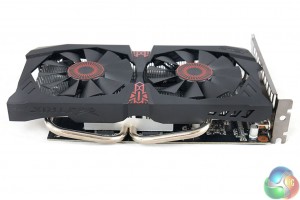
Two big heatpipes are visible along the top of the card. Thankfully, and unlike the previous Asus GTX750Ti OC which we reviewed back in March – the GTX750 Strix OC does not need additional power from a PCI e connector.



ASUS are using a direct touch heatsink. Interesting to see they have coated the heatpipes for appearance once they become visible outside the confines of the heatsink area. Twelve large fins (more like ‘blocks' really) run the length of the card to help deal with heat. As we know the GTX750 Ti is a cool running architecture, so it will be interesting to see how this design copes under extended load situations.

A GPUz overview of the ASUS GTX750 Ti Strix hardware – it is built on the 28nm process. The GM107 Maxwell core has 640 CUDA cores, 16 ROP's and 40 Texture units. The 2GB of Hynix GDDR5 memory is clocked at 1,350mhz (5.4 Gbps effective) and is connected via a 128bit memory interface.
On this page we present some high resolution images of the product taken with a Fuji XT1 and a Sigma SD1 camera. These will take much longer to open due to the dimensions, especially on slower connections. If you use these pictures on another site or publication, please credit Kitguru.net as the owner/source.



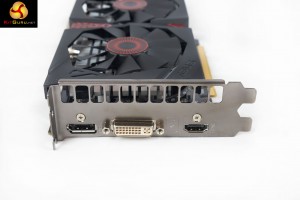
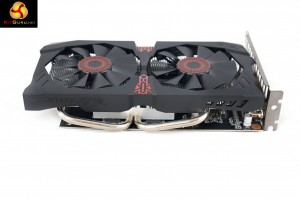
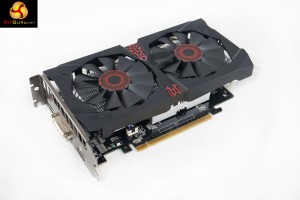



To test today we are using the latest Forceware 340.52 drivers and Catalyst 14.7 beta drivers.
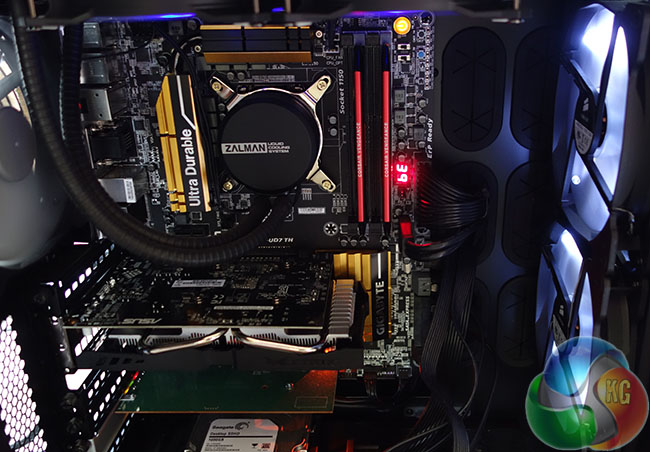
We are using one of our brand new test rigs supplied by DINOPC and built to our specifications. If you want to read more about this, or are interested in buying the same Kitguru Test Rig, check out our article with links on this page. We are using an Apple 30 inch Cinema HD monitor for this review today.
Comparison cards:
MSI GTX750 Ti OC Twin Frozr (1085mhz core / 1350mhz memory)
eVGA GTX760 SC (1072mhz core / 1502mhz memory)
Sapphire R7 265 Dual X (925mhz core / 1400mhz memory)
VTX3D R9 270X X Edition (1,080mhz core / 1400mhz memory)
ASUS R9 270 Direct CU II OC (975mhz core / 1,400mhz memory)
VTX3D HD7870 Tahiti LE (975mhz core / 1500mhz memory)
VTX3D VChamp HD7850 (1000mhz core / 1225mhz memory)
ASUS HD7850 (860mhz core / 1,200mhz memory)
Gigabyte GTX650TI (1,033mhz core / 1,350mhz memory)
Software:
Windows 7 Enterprise 64 bit
Unigine Heaven Benchmark
Unigine Valley Benchmark
3DMark Vantage
3DMark 11
3DMark
Fraps Professional
Steam Client
FurMark
Games:
Total War: Rome 2
Grid AutoSport
Tomb Raider
Battlefield 4
Watch Dogs
All the latest BIOS updates and drivers are used during testing. We perform generally under real world conditions, meaning KitGuru tests games across five closely matched runs and then average out the results to get an accurate median figure. If we use scripted benchmarks, they are mentioned on the relevant page.
Futuremark released 3DMark Vantage, on April 28, 2008. It is a benchmark based upon DirectX 10, and therefore will only run under Windows Vista (Service Pack 1 is stated as a requirement) and Windows 7. This is the first edition where the feature-restricted, free of charge version could not be used any number of times. 1280×1024 resolution was used with performance settings.


The final score of 21,668 points indicates good performance for older Direct X 10 games.3DMark 11 is designed for testing DirectX 11 hardware running on Windows 7 and Windows Vista the benchmark includes six all new benchmark tests that make extensive use of all the new features in DirectX 11 including tessellation, compute shaders and multi-threading. After running the tests 3DMark gives your system a score with larger numbers indicating better performance. Trusted by gamers worldwide to give accurate and unbiased results, 3DMark 11 is the best way to test DirectX 11 under game-like loads.If you want to learn more about this benchmark, or to buy it yourself, head over to this page.


A good result, just behind the reference clocked Asus HD7850.
3DMark is an essential tool used by millions of gamers, hundreds of hardware review sites and many of the world’s leading manufacturers to measure PC gaming performance.
Futuremark say “Use it to test your PC’s limits and measure the impact of overclocking and tweaking your system. Search our massive results database and see how your PC compares or just admire the graphics and wonder why all PC games don’t look this good.
To get more out of your PC, put 3DMark in your PC.”


A great score for the ASUS GTX750Ti Strix OC, almost on an even footing with the reference clocked ASUS HD7850.
Unigine provides an interesting way to test hardware. It can be easily adapted to various projects due to its elaborated software design and flexible toolset.
A lot of their customers claim that they have never seen such extremely-effective code, which is so easy to understand.
Heaven Benchmark is a DirectX 11 GPU benchmark based on advanced Unigine engine from Unigine Corp. It reveals the enchanting magic of floating islands with a tiny village hidden in the cloudy skies. Interactive mode provides emerging experience of exploring the intricate world of steampunk.
Efficient and well-architected framework makes Unigine highly scalable:
- Multiple API (DirectX 9 / DirectX 10 / DirectX 11 / OpenGL) render
- Cross-platform: MS Windows (XP, Vista, Windows 7) / Linux
- Full support of 32bit and 64bit systems
- Multicore CPU support
- Little / big endian support (ready for game consoles)
- Powerful C++ API
- Comprehensive performance profiling system
- Flexible XML-based data structures

We tested at 1080p with the settings shown above.


Overall performance is smooth, averaging almost 52 frames per second – just behind the overclocked R9 270 Direct CU II OC.
Valley Benchmark is a new GPU stress-testing tool from the developers of the very popular and highly acclaimed Heaven Benchmark. The forest-covered valley surrounded by vast mountains amazes with its scale from a bird’s-eye view and is extremely detailed down to every leaf and flower petal. This non-synthetic benchmark powered by the state-of-the art UNIGINE Engine showcases a comprehensive set of cutting-edge graphics technologies with a dynamic environment and fully interactive modes available to the end user.

We tested at 1080p with the settings shown above.


Excellent performance at 1080p – averaging over 50 frames per second.
Total War ROME 2 is the eighth stand alone game in the Total War series, it is the successor to the successful Rome: Total War title. The Warscape Engine powers the visuals of the game and the new unit cameras will allow players to focus on individual soldiers on the battlefield, which in itself may contain thousands of combatants at a time. Creative Assembly has stated that they wish to bring out the more human side of war this way, with soldiers reacting with horror as their comrades get killed around them and officers inspiring their men with heroic speeches before siege towers hit the walls of the enemy city. This will be realised using facial animations for individual units, adding a feel of horror and realism to the battles.


To test the cards today we use the ULTRA profile settings shown above at 1920×1080.

A demanding engine and one that works a little better on AMD hardware. Still the results are good, averaging 43 frames per second.
Tomb Raider received much acclaim from critics, who praised the graphics, the gameplay and Camilla Luddington’s performance as Lara with many critics agreeing that the game is a solid and much needed reboot of the franchise. Much criticism went to the addition of the multiplayer which many felt was unnecessary. Tomb Raider went on to sell one million copies in forty-eight hours of its release, and has sold 3.4 million copies worldwide so far.


We test with the ultimate settings at 1080p.

Frame rates are mostly good at 1080p but we did get a couple of performance dips close to 25 frames per second, and one just a little below. It would be possible to smooth out the frame rates a little by overclocking the Asus card, or by reducing image quality a little.
Grid Autosport (styled as GRID Autosport) is a racing video game by Codemasters and is the sequel to 2008′s Race Driver: Grid and 2013′s Grid 2. The game was released for Microsoft Windows, PlayStation 3 and Xbox 360 on June 24, 2014.


We test at 1080p with image quality settings set to ULTRA.
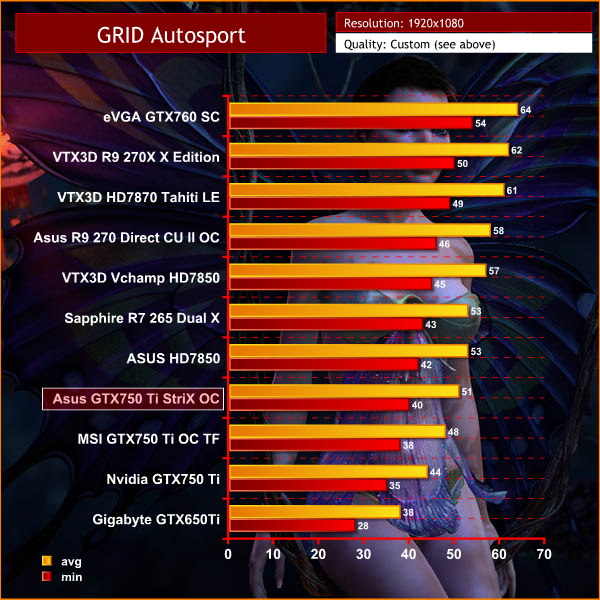
Smooth performance at 1080p, holding at 40 frames per second or above, at all times.
Battlefield 4 (also known as BF4) is a first-person shooter video game developed by EA Digital Illusions CE (DICE) and published by Electronic Arts. The game is a sequel to 2011′s Battlefield 3. Battlefield 4 is built on the new Frostbite 3 engine. The new Frostbite engine enables more realistic environments with higher resolution textures and particle effects. A new “networked water” system is also being introduced, allowing all players in the game to see the same wave at the same time. Tessellation has also been overhauled.
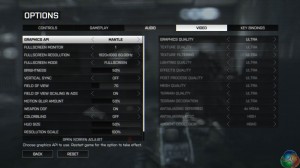
We test the Sapphire R7 265 in both ‘Direct X’ and ‘Mantle’ modes and compare against the GTX750 Ti cards. We are using the latest patch as of 8th September 2014.

This is a demanding engine at high image quality settings however we manage to get reasonable image performance at 1080p. The image quality could be a dropped a little to improve the minimum frame rate.
For Watch Dogs, Ubisoft Montreal built a new game engine called Disrupt.The engine was originally intended for a different game focused on driving. Ubisoft North American president Laurent Detoc explained that the team working on the project realized an open-world game was a better fit than their original vision.Watch Dogs runs in 900p on PlayStation 4 and 792p on Xbox One; both versions of the game run at 30fps. The PC version has received a lot of negative press due to the poor port from console.
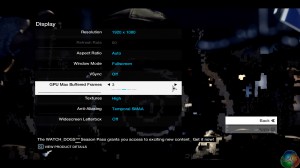

We configured the engine to run at 1080p with ‘high’ settings, as detailed above.

It would be fair to say that Watchdogs on the PC hasn't been the finest coding experience this century. We managed to get the game running pretty well, although it was still a little ‘juddery' especially in the vehicles at high speed.
The tests were performed in a controlled air conditioned room with temperatures maintained at a constant 23c – a comfortable environment for the majority of people reading this.Idle temperatures were measured after sitting at the desktop for 30 minutes. Load measurements were acquired by playing Crysis Warhead for 30 minutes and measuring the peak temperature. We also have included Furmark results, recording maximum temperatures throughout a 30 minute stress test. All fan settings were left on automatic.


The ASUS Strix Cooler is fantastic – when gaming, the temperature was held at 50c. This rose to 57c when stressing with the purely synthetic Furmark.
We are sometimes asked why we bother adding in Furmark results. Our belief is that it gives a rough indication of a ‘worst case scenario'.
We have built a system inside a Lian Li chassis with no case fans and have used a fanless cooler on our CPU. The motherboard is also passively cooled. This gives us a build with almost completely passive cooling and it means we can measure noise of just the graphics card inside the system when we run looped 3dMark tests.
We measure from a distance of around 1 meter from the closed chassis and 4 foot from the ground to mirror a real world situation. Ambient noise in the room measures close to the limits of our sound meter at 28dBa.
Why do this? Well this means we can eliminate secondary noise pollution in the test room and concentrate on only the video card. It also brings us slightly closer to industry standards, such as DIN 45635.
KitGuru noise guide
10dBA – Normal Breathing/Rustling Leaves
20-25dBA – Whisper
30dBA – High Quality Computer fan
40dBA – A Bubbling Brook, or a Refrigerator
50dBA – Normal Conversation
60dBA – Laughter
70dBA – Vacuum Cleaner or Hairdryer
80dBA – City Traffic or a Garbage Disposal
90dBA – Motorcycle or Lawnmower
100dBA – MP3 player at maximum output
110dBA – Orchestra
120dBA – Front row rock concert/Jet Engine
130dBA – Threshold of Pain
140dBA – Military Jet takeoff/Gunshot (close range)
160dBA – Instant Perforation of eardrum


Our noise meter is limited to accurately measure noise levels down to 28dBa.
The Asus GTX750 Ti Strix OC is a record beater and with good reason. Asus have set up a profile that ensures the fans don't spin at all until the core temperature hits around 52c-53c. When gaming, thanks to the excellent cooling system, the core held at 50c – meaning the fans were inactive.
Obviously those of you in a warmer environment may have to deal with some fan noise.To test power consumption today we are using a Keithley Integra unit and we measure power consumption from the VGA card inputs, not the system wide drain. We measure results while gaming in Crysis Warhead and the synthetic stress test Furmark and record both results.
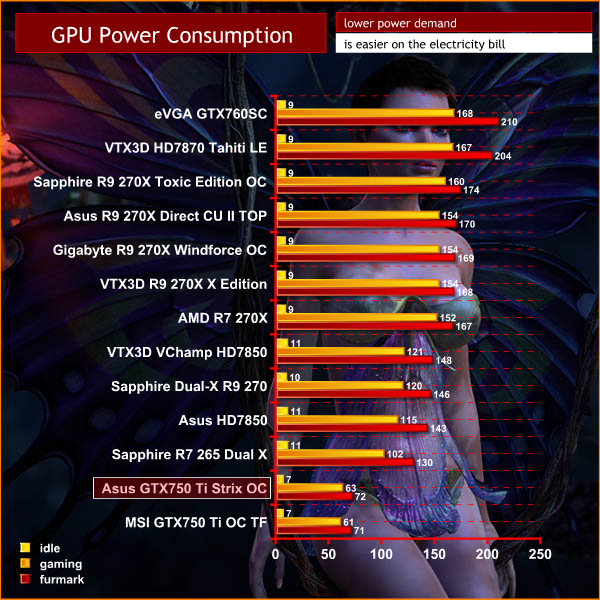
The Asus GTX750 Ti STRIX OC, like all Maxwell solutions we have tested is consuming very little power – hitting around 60 watts under gaming load. It takes all the power it needs direct from the PCI e slot.
Nvidia have such an advantage now when it comes to power efficiency – AMD have some way to go to make up lost ground. Look at the reference clocked HD7850 – it consumes 115 watts when gaming which is almost twice the demand of the GTX750 Ti in the same load situation.
To overclock the Asus GTX750 Ti Strix OC we used the latest version of MSI Afterburner, which is based on Rivatuner.


Even though the Asus GTX750 Ti Strix OC ships in a heavy state of overclock, we managed to push the core much further, maxing at 1,286mhz – which translates to 14.4% more. Memory speeds peaked at 1,549mhz (6Gbps effective).
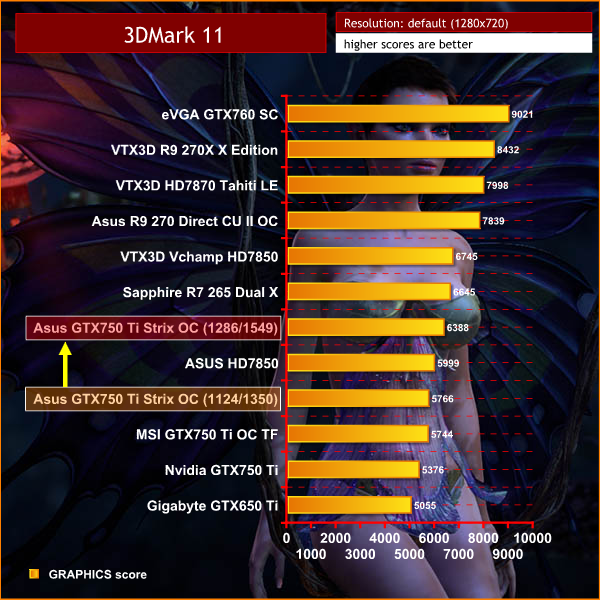

This healthy additional overclock pushed the score in 3DMark 11 to a graphics score of 6,388 points (from 5,766 points). This places the card well above the Asus HD7850 at 5,999 points. When we factor in that the HD7850 is consuming twice as much power – the benefits of the GTX750ti are clear.
Nvidia's Maxwell architecture really is quite remarkable and the GTX750Ti remains my first choice under £130. The Asus GTX750 Ti Strix OC is the best Nvidia partner card to date thanks in part to the spectacular cooling system.
The first ASUS GTX750Ti I reviewed back in March didn't impress me. Asus were the only Nvidia partner who added a 6 pin PCIe power connector and not only was it located in the most ridiculous position close to the I/O panel, but it didn't deliver any overclocking benefits at all over competitor solutions. Thankfully the Asus Strix OC solution is a monumental improvement.
We have analyzed the Asus Strix cooling solution before when paired up with fairly hot running AMD architecture. Depending on the load situation, the fan speed would adapt accordingly. In real world terms this meant that when idle, the fans would slow down dramatically, sometimes even stopping completely.
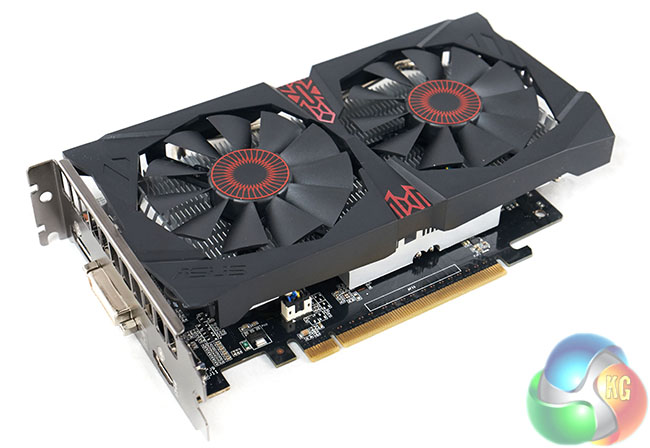
The Asus Strix fan algorithm is truly showcased on the GTX750Ti due to the cool running Maxwell architecture.
When gaming, we found that the fans often didn't spin at all – with the temperature hovering around the 49-50c mark. The direct touch heatsink proved capable enough of transferring heat from the GM107 core, without active fans aiding support.
We tested the cooler further, by sealing the case, and disabling chassis fans. Ambient temperatures rose inside the case and the fans did activate, spinning at around 700 rpm to maintain a thermal curve close to 54c. If your case is small and lacks airflow, we would take an educated guess that the fans will spin, albeit it, slowly.
Asus supply the card in a fairly high state of overclock, although our particular sample exhibited additional headroom close to 15 percent. When manually overclocked to 1,286mhz the Asus GTX750Ti Strix OC easily outperformed AMD's reference HD7850. While this in itself doesn't seem that remarkable, it is only when you factor in that it is consuming 63 watts at the slot. The HD7850 demands 115 watts and necessitates a direct feed from the power supply as well.
Right now the ASUS GTX750 Ti Strix OC ships with a price premium – Scan have pre-order stock for £138 inc vat. Considering you can pick up other custom cooled GTX750Ti solutions for less than £120, we do feel Asus need to drop their price below £130. In this specific market, £10 can make all the difference.
We do hope Asus will drop the price a little in the coming weeks.
Discuss on our Facebook page, over HERE.
Pros:
- best GTX750ti solution we have reviewed to date.
- Strix cooler is class leading.
- bags of overclocking headroom.
- cool.
- very quiet.
- takes all the power it needs from the slot.
Cons:
- a minor price drop is needed.
Kitguru says: The Asus GTX750 TI Strix OC is the finest showcase of the Maxwell architecture to date.

 KitGuru KitGuru.net – Tech News | Hardware News | Hardware Reviews | IOS | Mobile | Gaming | Graphics Cards
KitGuru KitGuru.net – Tech News | Hardware News | Hardware Reviews | IOS | Mobile | Gaming | Graphics Cards


